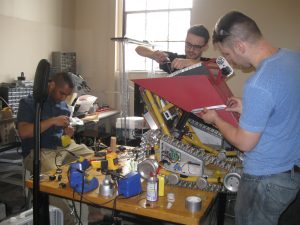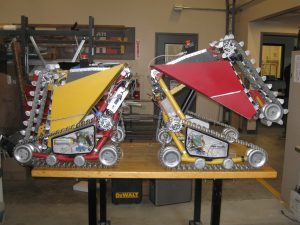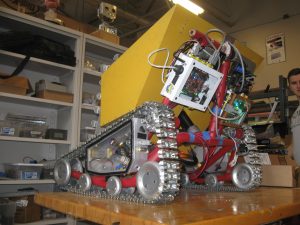For yet another summer, members of the Cyclone Space Mining team will leave behind Iowa’s rolling cornfields for the for palm tree-lined beaches of east central Florida.

Iowa State’s Cyclone Space Mining team will compete in the NASA Robotic Mining Competition at the Kennedy Space Center in Florida, just west of Orlando. This is the team’s eighth consecutive year in this competition. Their mission: to encourage development of innovative robotic excavation concepts for utilization of resources found on Mars.
NASA’s Robotic Mining Competition is a university-level competition designed to engage and retain students in science, technology, engineering and mathematics (STEM). The challenge is for students to design and build a mining robot that can traverse the simulated Martian chaotic terrain, excavate Martian regolith and deposit the regolith into a Collector Bin within 10 minutes.

This year, the 17 students lead by ME professor Jim Heise, professor of mechanical engineering, are taking their robots Space Ketchup and Space Mustard to the competition. These identical robots were built using the HERMES 4 system, which is an upgrade from models of previous years.
“Last year, our robots were hard to maintain,” says Jakob Hartl, president of the Cyclone Space Mining club. “This year, we didn’t want to waste time repairing. Our goal is to keep it clean and easily replaceable and testable, and highly-efficient. We beefed up the robots mechanically to prevent failure and set up control software, which allows for huge expansion in the future.”

Space Ketchup and Space Mustard (pictured) run on metal tracks and high clearance bodies to traverse past obstacles on the space mining course, which is filled with craters and rocks. “The tracks are how we move,” says Hartl. “These are some of the best tracks in the entire competition—they’ve never failed us. Regolith is much different than dirt or sand.”
After the robots traverse the course, the mining begins. “The conveyer mines for us”, says Hartl. “It spins counterclockwise to lift regolith, and then dumps it into the dual-sided hopper, which moves up and down. We can fit 65 kilos of regolith per robot in one dump cycle. Once it’s stored, the dust cover is taken off. The robots go back, traverse the obstacle field and dump the regolith into a bin.” Their goal is to collect a total of 500 kilograms in one run, which would break the record for the competition.
Currently, the robots are remote controlled and autonomous. The team says they are set for manual control and are working on making the robots more autonomous in the future.
The team’s big idea is to design through modification, or continuous improvement. “Each year we upgrade the robot, and this is the fourth rendition of the HERMES architecture”, says Hartl.

The goals this year were to make sure the frame is sturdy, to stick to a schedule to avoid time constraint, and to fine-tune the subsystems of the robots to be safe and well-constructed to avoid mechanical failure. The major things the team focused on for these bots were reliability, durability, accessibility and maintainability. The team also conducted stability testing know what speeds will work and how the center of gravity is influenced.
There have been challenges and obstacles to overcome, but the members remain positive, focused and driven. “There are no problems,” jokes team member Nick Hasto, “only pending solutions.”
The competition will be broadcast online here from 9a.m. through 5p.m. Wednesday and Thursday, and on Friday starting at 9a.m. through the last run of the day. You can find more information about specific times and other updates on the team’s Facebook page.
